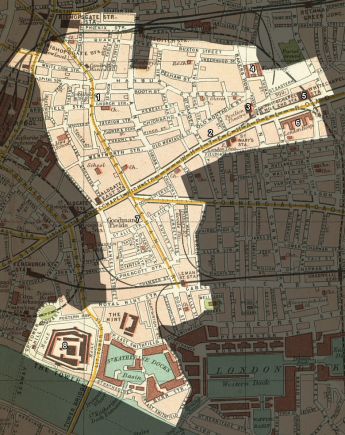VicLondon-Whitechapel
Whitechapel, the East End
|
District Traits
|
| Interactive: Access {{{Access}}}, Information {{{Information}}}, Prestige {{{Prestige}}} Reactive: Safety {{{Safety}}}, Awareness {{{Awareness}}}, Stability {{{Stability}}} |
Notable Locations
|
| x |
Class: x
Moving past Bishopgate, north of Commercial Road, is the district of Whitechapel. Its poverty is featured prominently in the scandal sheets and Parliamentary reports. The working class are the dominant class in the area, but middle class homes and shops line the main thoroughfares of Whitechapel and Commercial Roads. Much of the population is Irish, Germanic Jews, and poor Italians. As with St. Giles, most of them are transient and drunken, renting a bed or bench as they have the money. The public fountains and standpipes draw a constant stream of residents, who have to bathe in the open. People are sleeping in gutters, publicly relieving themselves, or even have sex in the alleys. The hotels and op houses are frequently rented out by sailors in town for a few days and looking for the cheap thrills of the district.
These pleasures are mostly set out on Whitechapel’s eponymous road: music-halls, theatres, and large public houses which feature a singer or small band, darts competitions, and other cheap entertainments. The more respectable of the theatres is the Pavilion, although the quality of the bill is questionable. There is the famed Ten Bells Pub on Commercial Street and Fournier, which offers excellent beer brewed on the premises since 1666. The food is good enough to draw workers from the nearby banking centres.
The streets of the area are packed with sales carts offering every kind of inexpensive goods from food products to furniture, books to boots, to second-hand clothes. By day, the district is clogged with food and vehicle traf c, and animals are much more common to see than in the West End or the City. The rats in this area of town are bold and can be seen scuttling around the walls of the buildings. Dogs, cats, and the occasional farm animal roam the alleys.
The other pleasures of Whitechapel are well-known and are frequently written about with concern by the newspapers and charitable societies. Prostitution, gambling dens, dog and rat ghting establishments, gin shops, and opium dens draw re from do-gooders in the city. These dark entertainments draw all levels of society, from the most base to the aristocracy. These illicit activities feed one of the most pro table of business sectors: crime. Organized gangs run certain areas of Whitechapel, specializing in various ‘services’. Robbery teams run the streets, especially at night, preying on the gentlemen slumming in the East End. They know that the embarrassment of even being in Whitechapel will keep their marks quiet; a gentleman in Whitechapel at night would be well advised to carry a sword cane or revolver. Protection is the most lucrative, the shaking down prostitutes and businesses, punishing people who ‘blow the gab’ to the peelers, or warning of the occasional police raid. Some of the larger gangs are even rumoured to have ‘rum’ judges on their payrolls. Frequently, these gangs aren’t just based on geographic position, such as a speci c block of the district, but also along family and ethnic lines. Irish tend to run with Irish, Jewish with the Jewish, Italians with Italians.
Rookeries dot the landscape in Whitechapel, ranging from lone buildings to entire blocks of tenements. These rookeries are sanctuaries for criminals and gangs protect them ercely. Police avoid these havens unless a raid is conducted in force. Even the low streets and alleys are considered dangerous for the copper who is not on the payroll of that particular gang, or has a reputation fearsome enough to stave off attack.
Unlike the larger or more prosperous industry of the rest of the city, the factories and shops here tend to work their employees longer, harder, and dismiss them for any reason. Chemical works like matchmakers, drug manufacturers, and dye-makers are common throughout the district and give the place its characteristic sulphurous scent. Cheap weaving and dressmaking, tinker, tailors hire many from the area. Hanbury’s Brewery is on Brick Lane and is a major employer in the area.
Whitechapel Road is also home to London Hospital, a large facility that caters to the poor and which receives much of its operations funds from charitable donations. The hospital is constantly on the edge of insolvency at this time and has to charge its patients a nominal fee for services. Most of their clientele cannot afford this. London Hospital also has questionable quality of care, more due to the lack of funding with which to draw better physicians. Across from the hospital are the twin stations of Whitechapel and Whitechapel Mile End Stations. The rst handles train and tram traf c, the second is the nal terminal for the Whitechapel line of trams. Further east, just past Cambridge Road is the Trinity Alms House, where the poor are provided a place to stay for the night and a simple meal.
Also dedicated to the aiding the poor is the Baker’s Row Workhouse, an imposing ve story red brick slab with a series of arch-topped windows regularly running about all of the oors. Located across from Coverly Fields, with its crowded burial ground (which goes out of use in the early 1890s), and the Union In rmary. The workhouse is segregated by sex, with men in the west wing, women in the east. The ground oor contains the of ces for the porters and overseer, the second and third oors are reserved for the living quarters of the inmates, and the uppermost oor is set aside for children under the age of fourteen. The living quarters are an open bay, the better to protect the occupants from their own natures and allow the staff to monitor their behaviour. Kitchen and canteen occupy the crossbar of the H shape that the building takes when viewed from above. These rooms are used for Sunday services, as well.
